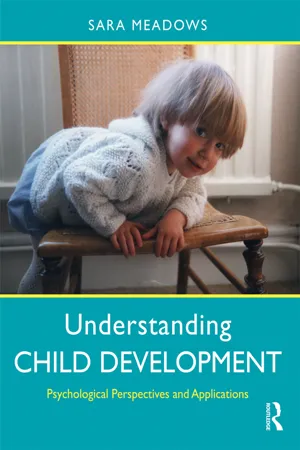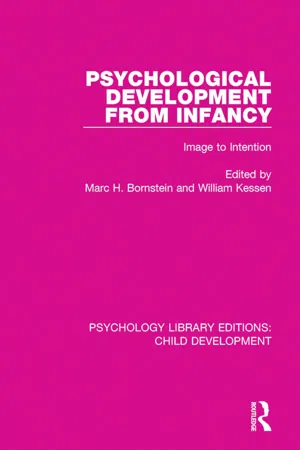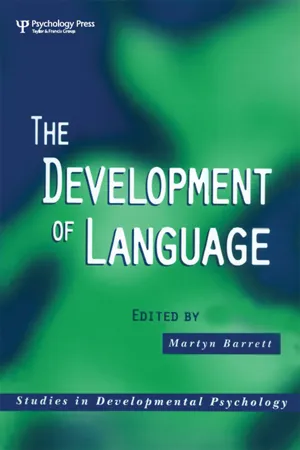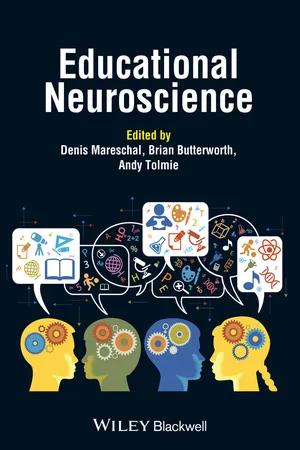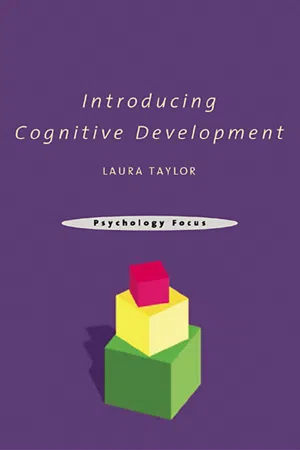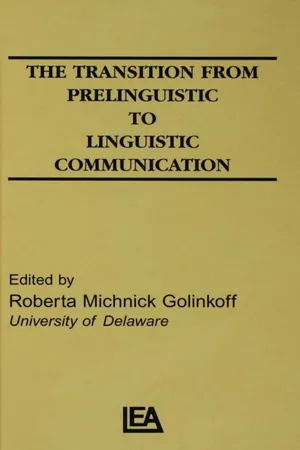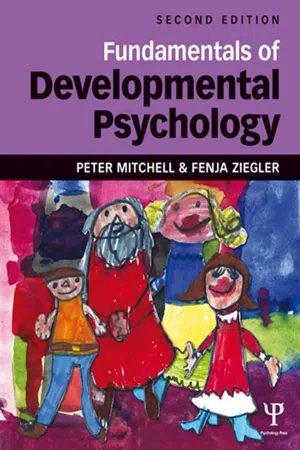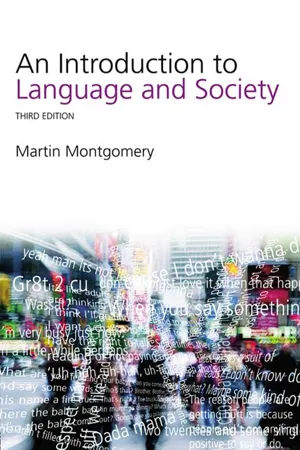Psychology
Language Development in Infancy
Language development in infancy refers to the process through which infants acquire and refine their ability to understand and produce language. This includes the development of receptive language skills (understanding words and sounds) and expressive language skills (producing words and sounds). Infants go through various stages of language development, from cooing and babbling to eventually forming words and simple sentences.
Written by Perlego with AI-assistance
Related key terms
11 Key excerpts on "Language Development in Infancy"
- eBook - ePub
Understanding Child Development
Psychological Perspectives and Applications
- Sara Meadows(Author)
- 2017(Publication Date)
- Routledge(Publisher)
Chapter 6 Language Development■ Infants’ Perception of Speech Sounds■ Infants’ Production of Speech Sounds■ Beginning to Use Words■ Words and Their Functions: Using Words as Names■ Constraints on Learning New Words■ The Growth of Vocabulary■ From Single Words to Sentences■ Language Acquisition Devices■ Language Acquisition Principles■ Language Acquisition Support Systems■ Children’s Metalinguistic Behaviour■ Children with Specific Language Impairment■ Biological Bases of Language DevelopmentLanguage development has been one of the most enthusiastically discussed areas of child development. There have been proposals that it is genetically programmed in ways built up by evolution and wired into the brain, and proposals that it is all down to exposure to others’ language. And because we all think language is enormously important and want the best sort of development, there has been a lot of debate and a lot of posturing in defence of quite extreme positions. The truer picture is more complicated, more developmental and more embedded. The development of language provides a good example of epigenesis, and its later stages also involve consideration of eco-systems.Human infants clearly start with a great many capacities and pieces of behaviour suited to language, but they are also born into communities which use language and expect the infant to use it too. On the whole, all except the severely impaired develop language in similar ways, though at varying rates: but the details of the language and how it is used are heavily influenced by the child’s experience. Through development, language functions as a means of communication, as a means of reflecting on and re-organising experience, and as a way to receive and transform the accumulated knowledge and values of the community. Using language is thus a central part of human existence. (For reviews, see Clark 2016; MacWhinney 2015; Meadows 2006.) - eBook - ePub
Psychological Development From Infancy
Image to Intention
- Marc H. Bornstein, William Kessen(Authors)
- 2017(Publication Date)
- Routledge(Publisher)
British Journal of Psychology, 1975, 66, 181–192.Passage contains an image
Katherine Nelson13 The Role of Language in Infant DevelopmentGraduate Center,City University of New YorkINTRODUCTION
Development of language by the human infant is as nearly universal as walking, and the child escapes from it only at the peril of severe physical, mental, or emotional disability. Yet, despite the enormous body of work on the development of language that has emerged in recent years, we are still far from having an answer to the basic question with which this chapter is concerned: How does the infant master language and in so doing become transformed into a child? In many ways, mastery of language is the key transition between infancy and childhood, and thus it is important to examine its basis in infant development. As we will see, however, achievement of cognitive and social prerequisites in infancy do not automatically produce a language user, and essential transition points remain unstudied and undefined. It is the purpose of this chapter to identify these gaps in our knowledge as well as to set to forth a hypothesis as to what we will find when we look at those gaps.Recent research on language development has tended to follow one of two directions: to specify stages in the acquisition of an adult grammar, or, in a more recent turn, to emphasize the roots of linquistic competence in prelanguage development. These approaches represent efforts to understand the acquisition of language and to understand the relation of language to infant development, but the two have not yet made contact with each other. For the most part they do not even overlap. We have on the one hand the infant arriving at the end of the first year of life ready to speak a few words, equipped with cognitive and communicative skills that enable him to understand and begin to produce words. We have on the other hand the almost- child at the end of the second year, beginning now to combine a few words into two-word sentences, having arrived at last at Stage I of grammatical development (Brown, 1973). What has happened in between? According to this brief summary, and contrary to most people’s assumptions, very little overt progress in language has taken place during this year. Moreover, as we shall see, this is not because dramatic progress is being made in other growth systems during this time. Indeed, much of the second year appears to be spent on a developmental plateau. This statement must be somewhat tentative because, in point of fact, surprisingly little is known about development in the second year of life. - eBook - ePub
- Martyn Barrett(Author)
- 2016(Publication Date)
- Psychology Press(Publisher)
The full, species-typical capacity for language is realised gradually, in phases—coherent ontogenetic periods during which specific cognitive and neural capabilities associated with some aspect of language, or the path to it, “come on line”. Phases in the development of linguistic capacity should not be confused with stages in the development of language. The latter usually refer to “child developments” such as crawling and one-handed grasping; or “language developments” such as babbling and two-word utterances. Stages are superficially descriptive, at best, and occasionally misleading. They do not say anything about what the infant experiences when babbling, the cognitive processes by which the words that co-occur in phrases get combined, or how any of the later behaviours are facilitated by earlier ones.“Language”, viewed broadly, depends on two component systems: a social cognition network that is responsible for lexical acquisition and a grammatical system that carries out utterance analysis (at levels corresponding to linguistic units) and computation. Social cognition is a neural specialisation that comprises individual operations. Before the socially cognitive system acquires utterances, and certainly before grammatical capability is activated, a number of behavioural capabilities develop and a number of different precursive operations are carried out by the infant. Some of these have been functionally linked to lexical development. Others may be so linked in the future, since research in this area has begun only recently.Socially cognitive operations that may or do facilitate utterance acquisition include vocal learning. In the vocal learning phase of language development, infants learn and respond to properties of the human voice. This learning begins prenatally (DeCasper, Lecanuet, Busnel, Granier-Deferre, & Maugeais, 1994). Newborns typically prefer their mother’s voice to the voices of other women (DeCasper & Fifer, 1980) and display a preference for the “language” spoken by the mother during pregnancy (Moon, Cooper, & Fifer, 1993). The infant’s initial preference for the mother’s “voice” may thus be a preference for her speech—the sound pattern of her language as well as any personally identifying information. - eBook - ePub
- Denis Mareschal, Brian Butterworth, Andy Tolmie(Authors)
- 2013(Publication Date)
- Wiley-Blackwell(Publisher)
Pioneers in language education, such as Conn (1971) and Hutt (1986), have recorded the characteristics of the populations of children they worked with, and the special educational approaches they developed, based on a combination of experience and theoretical insight. These pioneering educational programmes, inspired by the severe and specific language deficits of children identified at the time, correspond in some ways to the neuropsychological advances that followed the discovery and detailed study of classic cases of brain injury of the nineteenth and twentieth centuries. In acknowledgement of the importance of these insights, we include in this chapter a single case study of an individual, TZ, who benefited from the highly specialized educational approaches developed by Hutt and her colleagues. Particularly valuable, we believe, are the reports of the educational principles and the specific materials and intervention strategies that operated so effectively.Language in Infancy and Early Childhood 0–5 yearsBy the time children enter a formal educational setting at age five or six, the majority have achieved levels of receptive and productive language not unlike those of their adult tutors, including a mastery of syntax and the ability to produce complex narrative. Indeed, language at this point is arguably the most developed cognitive skill. However, a substantial degree of variability is also seen at this stage, in terms of both what children can produce and what they can understand (see, e.g., Bates, Bretherton, & Snyder, 1988; Fenson, Dale, Reznick, Bates, & Pethick, 1994). We therefore begin here with a consideration of how individual differences and environmental factors over these early years result in the extent of variability seen by mid-childhood.The impact of intrinsic factors on language development
Several recent studies have considered which aspects of the language system in infancy best predict language outcomes in the preschool and school period. Prominent among them are those that consider how infants perceive and make sense of the speech stream, the first requirement of which is to develop categorical representations of phonemes, the smallest meaning-carrying unit of speech (see, e.g., Davenport & Hannahs, 2010, for an introduction). The phonemes that make up any given language are in fact categories of sounds: phonemic categories , as the exact acoustic properties of speech sounds vary slightly depending on factors such as speaker and word context. In a continuous acoustic space the same magnitude of difference between speech sounds could either not be encoded if these sounds fall within a category or, by contrast, define a critical linguistic contrast if they cross a category boundary. For example, the acoustic differences between the phonemes “p” and “b” in “pin”, “spin” and “bin” are about equal, but in English two fall within the same category space, “p”, which is linguistically distinct from the category “b”. To be able to establish which contrasts are linguistically relevant and which are not draws on two fundamental properties of auditory processing: the first is sensitivity to the rapid auditory transitions that often define critical contrasts between phonemes (see Rosen, 1992); the second is to be able to categorize inputs finely, something that is more generally considered to be a fundamental principle of cortical learning. The establishment of phonemic categories is a crucial building block in language learning, and as such is an excellent illustration of the interaction between environmental input and low-level brain mechanisms such as rapid processing or categorization, which here will be referred to as - Available until 10 Jul |Learn more
Early Language Development
Implications for Clinical and Educational Practice
- John Harris(Author)
- 2020(Publication Date)
- Routledge(Publisher)
Part twoExplanations of Language DevelopmentPassage contains an image
Chapter fourIs language learned?Introduction
At the beginning of Chapter 1 it was suggested that linguists and psycholinguists interested in children's language have addressed two major questions. First, what are the changing patterns of language abilities which characterise development? And, second, what are the processes by which developmental change occurs? The next two chapters are concerned with this second question and present a brief overview of different explanations of how language development occurs.As we have seen in the preceding chapters, language development gives rise to a complex set of interrelated abilities. Motor abilities, perceptual skills and increasingly sophisticated forms of cognitive representation are all implicated in the mastery of spoken language. Furthermore, an adequate characterisation of spoken language requires the integration of descriptive frameworks from different branches of linguistics and psychology. In view of the complexity of the psycholinguistic abilities which contribute to normal language functioning, it is perhaps not surprising that attempts to explain how these abilities emerge in the first place and are orchestrated into the unified process which we recognise as language have met with only limited success. This chapter and Chapter 5 consider the three most popular theories of language development to emerge in recent years, beginning with the publication of Skinner's book Verbal Behaviour in 1957.At this point it is also worth considering the relevance of theories of normal developmental progress to a book concerned with the assessment and treatment of children with language difficulties. It might be argued that children experience difficulties in the area of language development precisely because the normal developmental processes have broken down. In order to help such children, it is necessary to introduce novel and artificial procedures to assist learning and it is therefore unlikely that an understanding of normal processes will be of any help. The alternative view is that an understanding of how normally developing children learn language is essential, first, in order to understand why a child is experiencing difficulty and, second, to provide insights into the best and most effective strategies for remedial intervention. It is this second view which is reflected in this chapter and the next, and in Chapter 11 - eBook - ePub
Cognitive Development and Cognitive Neuroscience
The Learning Brain
- Usha Goswami(Author)
- 2019(Publication Date)
- Routledge(Publisher)
Chapter 6 Contents Phonological development Lexical development Grammatical development Pragmatic development Summary6
Language acquisition
KEY TERMS
Language acquisition device (LAD)
An innate neural mechanism, first suggested by Chomsky, with the special job of acquiring the language the infant encounters.Phonotactic patterns of language
Speech sounds that make up language, and the order in which these speech sounds can be combined to make lawful words.So far in this book, we have considered cognitive development largely independently of language. This is not accidental. Language acquisition has traditionally been studied separately from cognition, and as we have seen in previous chapters, there is strong commitment to the idea that basic concepts are pre-verbal. Another reason for the traditional distinction between language and thought was that language acquisition seemed such a remarkable feat for the infant brain that it was assumed that special capacities must be at work. These capacities were thought to be distinct from the capacities underpinning broader cognitive development. For example, it was postulated that infants were born equipped with a ‘language acquisition device’ or LAD, which had the special job of acquiring the spoken language of whichever culture the infant entered. Chomsky, the original proponent of the LAD, argued that infants are born with innate knowledge of the general rules that all languages obey, along with innate knowledge of permitted variations (e.g., Chomsky, 1957). Hence an infant can as readily acquire a language that makes heavy use of the passive tense (“The boy was bitten by the dog”), like Sesotho, as a language that does not, like English (“The dog bit the boy”; Bates, Devescovi & Wulfeck, 2001).More recently, it has become clear that language acquisition depends on the same kinds of learning mechanisms that underpin broader cognition. We have already seen in Chapters 1 to 5 that infants acquire a remarkable amount of information simply by looking at and listening to events that occur in their worlds. In the case of the physical, biological and psychological worlds, the primary sense is probably vision. In the case of language, the primary sense is audition. Infants acquire a remarkable amount of information simply by listening to what the people around them say. I will argue that infants use the same abilities to acquire language that they use to acquire knowledge about the physical, biological and psychological worlds, for example statistical and associative learning. The infant brain is automatically tracking statistical dependencies and conditional probabilities in language. Auditory perceptual information is replete with statistical patterns. There are acoustic cues to the phonotactic patterns of the language (the sounds that make up the language, and the orders in which they can be combined), to word boundaries and phrasing (largely carried by speech rhythm and duration cues), and to the emotional content of speech (largely carried by prosodic stress patterns and loudness cues). As in the visual world of objects and events, information that is initially gained passively via automatic neural encoding processes is rapidly supplemented by information gained through direct action by the infant, for example by imitation. In the case of language, infants start babbling and trying out sound combinations for themselves from very early on, and they also initiate verbal interactions by gooing and making comfort or distress sounds – in other words, they attempt to communicate - eBook - ePub
- Laura Taylor(Author)
- 2004(Publication Date)
- Psychology Press(Publisher)
According to Chomsky, then, the child’s biology is in charge of language acquisition. The LAD equips the child with some basic knowledge of linguistic rules and a tendency to attend to language over and above other things (as well as to attend to specific features of language). As the brain matures, more cognitive resources (information-processing abilities) are available to the child and, as such, have the ability to process more and more linguistic input.Although innate tendencies and biological maturation are thought to underlie language development, it is obvious that children actually need to be exposed to a specific language to learn it. However, unlike many other theories of language acquisition, nativist theories such as that of Chomsky, suggest that children are passive participants in the learning process and that they do not actively try and learn language. Likewise, it is thought that the role of other people in a child’s language development is minimal and that other people must simply speak to the child or speak to someone else while the child is listening for the child to acquire language; no formal teaching or learning is required. Nativist theories such as Chomsky’s stand in contrast to the next type of theory to be discussed.Behaviourist theory
Behaviourist theories suggest that, rather than being born with any innate linguistic abilities or tendencies, children acquire language gradually as a result of learning. Other people are said to be the main contributors to this process. It is proposed that imitation and behaviour shaping are the main mechanisms underlying language acquisition. So the process is a two-way one; infants imitate others and other people shape the infant’s attempts at language. Infants learn about the nature and function of language within the context of their early relationships. Their babblings become more “word-like” as a result of the selective reinforcement given by those with whom the infant interacts. For example, “dadadada” might be reinforced initially by the “other” but then reinforcement would be withheld until the child uttered something more “word-like”, e.g. dada. Similarly, utterances that are not word-like would not be reinforced. - R. M. Golinkoff(Author)
- 2013(Publication Date)
- Psychology Press(Publisher)
6 Setting the Stage for Language Acquisition: Communication Development in the First Year Carol Gibb Harding Loyola University of ChicagoThis chapter must begin with a caveat. Although the purposes of this volume are to investigate the transition from prelinguistic to linguistic communication and to ascertain the relationship (if any) of developments in the pre-language period to language acquisition, this chapter fulfills neither purpose. Only prelinguistic communication is investigated and its investigation as described here, in no way permits a conclusion about the relationship of prelinguistic communication to language. The rather nebulous description used in the title, “Setting the Stage.” reflects this limitation. Communicative developments during the first year do set the stage for language acquisition, but so do other events and probably in even more critical ways, for example, as in conception and birth. The question that I think we would like to answer goes beyond setting the stage. This question is whether or not the development of prelinguistic communication provides the necessary and/or sufficient conditions for linguistic communication. Although in this chapter I will describe achievements of the prelanguage period and make some speculations about how these achievements may culminate in the acquisition of the first words, my caveat remains: Do not expect too much. The infants I have observed were only beginning to use their first word-like vocalizations at the last observation. Although the use of these first words seemed to derive from earlier non-verbal communicative patterns, the findings reported do not eliminate the possibility that: (1) other sources of language learning were present (e.g.. innate language structures), as posited by Chomsky (in Piattelli-Palmarini. 1980); or that (2) these first words would have been used even without the earlier communications. In either case, prelinguistic communication might be neither necessary nor sufficient to explain linguistic communication.- eBook - ePub
- Peter Mitchell, Fenja Ziegler(Authors)
- 2013(Publication Date)
- Psychology Press(Publisher)
12 DOI: 10.4324/9780203736357-12Contents
Introduction The components of language A description of language development Vocabulary development Theories of language acquisition Chomsky’s theory of innate language development A second look at the environment SummaryLanguage development 12
Chapter Aims- To introduce the properties of language.
- To introduce the components of language.
- To chart the path of language development.
- To contrast different theories of language acquisition.
Introduction
Language has been described as the jewel in the crown of cognition (Pinker, 1994 ). Indeed, our ability to use language is often cited as something that sets us apart from other animals. However, on a fundamental level language is something we use to communicate, and there are many other living things that communicate with each other. For example, bees convey the location of rich sources of pollen to other inhabitants of their hive with an elaborate “dance.” Is this dance something we should call language? Human language is similar to bee dancing in that both are tools of communication, but in other respects they are very different. Bee dancing is not a language, and it is better to reserve the term for the system of communication used by humans. The reason for this will become clear when we take a look at what language is and how children learn it.None of us can remember much about our first attempts to acquire a mother tongue. However, many of us do have the experience of trying to learn a second language, and that gives insight into the complexity of the process. It is sometimes said that the easiest way to acquire a second language is to pick up an extensive vocabulary - eBook - ePub
- Martin Montgomery(Author)
- 2013(Publication Date)
- Routledge(Publisher)
The third consideration is of a very different order. There is an accumulating body of evidence that learning a first language can only be accomplished within a critical developmental period. So called ‘feral’ children, for example, who have managed to survive the first few years of life with little known human contact, have great difficulty advancing beyond the most limited linguistic expressions, even when subjected to explicit language training. Similarly, children who are born profoundly deaf respond less well to speech training than those in whom severe loss of hearing occurs later, especially if this happens after the critical learning period has passed. In the light of factors such as these, there is now a growing consensus that the critical period for beginning the development of a first language comes within the first three years of life. If through some special set of circumstances a child is unable to begin the process by this point in the maturational cycle, then s/he will develop language only slowly and with great difficulty, whatever his/her other abilities.The notion of a critical learning period is not easily accounted for within the imitation perspective, since the generalized procedures of imitation, memorization and selective reinforcement imply no attendant time limit on when they can be applied.An alternative position: ‘nativism’ — an innate capacity for language
These criticisms of the imitation perspective have lent weight to a counter position which argues that humans in general have a special and distinctive language-learning faculty which makes possible the learning process: it equips us with an unconscious awareness of certain basic properties of language itself and it comes into play at a predetermined stage in the maturational cycle. This innate knowledge, it is claimed, is part of every human's genetic inheritance, transmitted at conception, and merely activated at a particular moment in the early years of life by the necessary linguistic environment. All that is required is a context of others speaking a human language for us to begin the task of breaking the language code and implementing it in use. In this sense, discovering the patterns and structures of a language — such as, for example, the markers of plural or of past events — is only possible on the basis of a subtle preparedness. For, in framing and refining such hypotheses, the child is working within a generally inherited, genetically endowed, predisposition to learn language. It is his/her special and distinctive language-learning faculty that dictates what to look for and where to look: by virtue of it s/he already possesses part of the language blueprint. - eBook - ePub
Language and Communication in Mental Retardation
Development, Processes, and intervention
- Sheldon Rosenberg, Leonard Abbeduto(Authors)
- 2013(Publication Date)
- Psychology Press(Publisher)
chapter 2 , prelinguistic developments are thought to play a minimal role in many linguistic achievements according to a number of recent theoretical treatments of language acquisition (e.g., the parameter theory of Chomsky).In the Smith and von Tetzchner (1986) study, a Norwegian version of the Reynell Developmental Language scales (Hagtvet, 1979) was administered to the subjects in addition to the measures of communicative functioning described earlier. The Reynell scales are designed to tap attainment of developmental milestones in several areas of language (e.g., syntax, the lexicon) and in both the receptive and expressive modes. These researchers found that the declarative and imperative task performance of the subjects with Down syndrome at age 2 years was positively correlated with their Reynell scores at age 3 years.Although these correlations could arise if, as Smith and von Tetzchner (1986) claimed, prelinguistic indicating and requesting behaviors are prerequisites for mastering certain facets of the linguistic system, other possibilities exist. For instance, recall that some of Smith and von Tetzchner’s subjects had some facility with language and that linguistic attempts at indicating or requesting received higher scores than did nonlinguistic attempts. This raises the possibility that the predictive correlations observed by Smith and von Tetzchner mean only that there is some consistency over time in the rate at which children with Down syndrome attain various linguistic milestones.In the study described earlier, Mundy et al. (1988) also administered the Reynell scales to their subjects. These researchers, however, examined concurrent relations between nonverbal communicative performance and language skill (i.e., relations at one point in time) but not predictive relations (i.e., relations between a measure taken at one time and another measure taken at a later time). They found few significant correlations among measures for the most cognitively advanced half of their subjects (i.e., those with an average MA near 28 months) in each group. For the less cognitively advanced subjects (i.e., those with an average MA near 16 months), the frequency of nonverbal requesting was correlated with Reynell receptive and expressive scores for the Down-syndrome group, whereas nonverbal indicating was correlated with these two language measures for the nondisabled group.
Learn about this page
Index pages curate the most relevant extracts from our library of academic textbooks. They’ve been created using an in-house natural language model (NLM), each adding context and meaning to key research topics.
